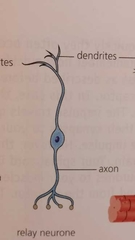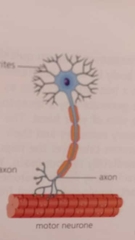![]()
![]()
![]()
Use LEFT and RIGHT arrow keys to navigate between flashcards;
Use UP and DOWN arrow keys to flip the card;
H to show hint;
A reads text to speech;
27 Cards in this Set
- Front
- Back
|
What does the nervous system do in animals |
Nervous systems control voluntary and involuntary actions and responsible for transmitting and receiving impulses in different parts of the body |
|
|
CNS |
Central Nervous System, a network of nerves that spreads from the CNS throughout your body |
|
|
What does the CNS consist of? |
Brain and spinal chord |
|
|
Nerves |
Made from bundles of individual neurones |
|
|
Process |
STIMULUS -> Receptors -> Sensory Neurone-> Synapse -> CNS (relay neurone) -> motor neurone -> effectors -> RESPONSE |
|
|
Receptors |
Detect a change inside OR outside your body. Respond to different stimuli |
|
|
CNS |
Co-ordinates your bodys response |
|
|
Effectors |
Cause a response by moving part of your body or secreting a hormone |
|
|
Messages in the CNS |
Sent along the nerves are electrical and they move quickly along the nerves |
|
|
Myelin Sheath |
Longer nerves have them to insulate the impulses which are over 250mph |
|
|
How are electrical impulses generated |
Generated by special cells called receptors and travel to your brain and or spinal chord |
|
|
Where are most of your receptors |
Fingertips |
|
|
Where are the least receptors |
Soles of your feet and elbows |
|
|
Glands |
Produce and secrete hormones into your blood stream |
|
|
Sensory Neurone |
A neurone that carries an electrical impulse from a receptor to the CNS |
|
|
Relay Neurone |
Once inside CNS pass along relay neurons that carry electrical impulses around the CNS |
|
|
Motor Neurones |
Carries an electrical impulse to an effector |
|
|
Effector |
Muscle or Gland, muscles can contract and relax to help you move in response |
|
|
Structure of Sensory Neurone |

|
|
|
Structure of Relay Neurone |

|
|
|
Structure of Motor Neurone |

|
|
|
Responses |
Receptors detect changes in your environment or body. Send electrical impulses along sensory to CNS that gets a suitable response Impulses are sent to your muscles along motor neurones to make you move |
|
|
Synapses |
A gap between axon of one nerve and the dendrites of another where chemical neurotransmitters transmit the impulse |
|
|
Dendrites |
The branched beginnings of neurones which can detect chemical neurotransmitters and start another electrical impulse |
|
|
How impulse is passed from neuron to another |
Electrical impulse reaches the end of the axon, neurotransmitters convert impulse into chemical signals and diffuse across the synapse Chemical signal meet neurotransmitters at the dendrites of the next nerve cell Bind to receptors and trigger an electrical impulse |
|
|
What happens to neurotransmitter |
Broken down by enzymes to stop the second neurone from sending new impulses |
|
|
Reflex Arc |
Automatic responses happen quickly Do not require your brain to make a decision, skips the CNS |

